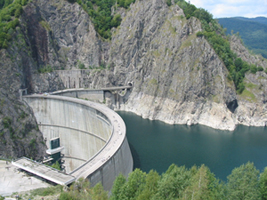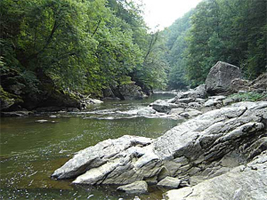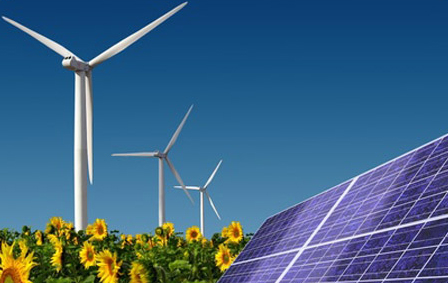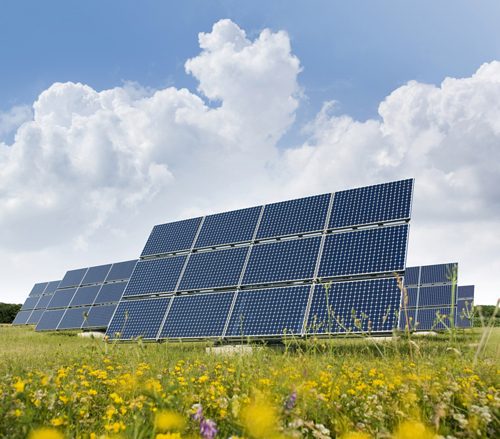
|
|
 |
 |
TECHNICAL ASSISTANCE ELECTRICAL ENERGY PRODUCED FROM RENEWABLE SOURCES Renewable energy sources derive from natural processes that are replenished constantly. Electricity generated from solar, wind, ocean, biomass and geothermal resources can be captured using different methods. Non-renewable energy resources include nuclear power as well as energy generated from fossil fuels such as: petroleum, coal and natural gas. These resources are limited and non-renewable. Renewable energy resources include wind, solar, ocean, marine, hydropower, geothermal resources and biomass: biodiesel, bioethanol, biogas. All these sources are harnessed and used to generate electricity, hot water, etc. 1. Hydropower resources are provided by slow and moderate flowing streams of water, which are not included in large hydropower schemes, located in hilly and mountainous areas, with optimal flows and falls for achieving energy efficiency.
Projects for harnessing hydropower resources: In 2007, TechnoCAD S.A. prepared the “Study for developing a strategy for high potential and sustainable development of the area of Baicu Valley (town Dragomiresti, Maramures county)”. Considering the potential and the convenient location of the stream, including the possibility of achieving economic and touristic objectives, the Local Council of Dragomiresti was advised to try to attract foreign investors willing to build a micro-hydroelectric power plant in the area. Between 2008 - 2010, TechnoCAD S.A. provided consulting services for the development of hydropower plants on the following rivers: 2. Wind power resources
There were established favourable natural conditions for the exploitation of wind energy resources (constant wind speed between 6 – 10 m/s), both in plain areas (Satu Mare county) and alpine plateaus (Bistrita Nasaud county). Projects for harnessing wind power resources: In this field TechnoCAD S.A. provides:
3. Solar energy
Solar energy is the energy derived from the sun through the form of solar radiation. It can be used to generate electricity, to heat the air or the water. Although solar energy is renewable and easy to produce, the main problem is that the sun does not provide constant energy throughout the day because of the day-night alternation, weather conditions and seasons change. Solar installations are 2 types: thermal and photovoltaic. Photovoltaic panels generate electricity for free, while thermal installations help to save gas and wood in proportions of 75% per year. A house which is provided with both solar installations (photovoltaic and thermal panels) can be considered energetically independent (since the energy accumulated in the batteries at daytime is sent to the network and used as needed). Solar panels produce electricity (approximately) 9 hours/day (the calculation is made on minimum, winter days have 9 hours), supplying constant power to on-board consumers and recharging the batteries at the same time. Solar installations are efficient even when the sky is cloudy. They are also hail resistant (the best panels). 4. Energetic independence
Energetic independence can be achieved: Example of energetic calculation for a household with the following appliances:
o meet the consumption needs it could be used: Main steps of Electrical Energy from Renewable Sources investments ( E-RES): TechnoCAD S.A. can prepare the necessary documentations to obtain the permits and agreements to establish a hydroelectric plant: TechnoCAD S.A. can also prepare the documentations for obtaining licenses, permits and approvals issued by central, county or local authorities: At customers’ request, TechnoCAD S.A. can set up the documentation for obtaining the agreements from ANRE: Legislation and regulations in force Government Decision no. 443/2003 concerning the promotion of electricity produced from renewable energy sources, with the latest modifications. This latter Government Decision was amended by Government Decision 958/2005 (transposing Directive 2001/77/EC) and forms a legal framework for the promotion of renewable sources of energy. This will have a direct impact on the reduction of energy consumption.
Government Decision no. 1535/2003 concerning the National Strategy to harness renewable energy sources. Government Decision no. 1069/2007 on approving the Romanian Energy Strategy for the years 2007-2020. |
|||||||||||||||||||||||||||||||||||||||||||||||||||
 |
|||||||||||||||||||||||||||||||||||||||||||||||||||||
TECHNICAL ASSISTANCE |
|||||||||||
© TECHNOCAD - Departament MULTIMEDIA |
|||||||||||






